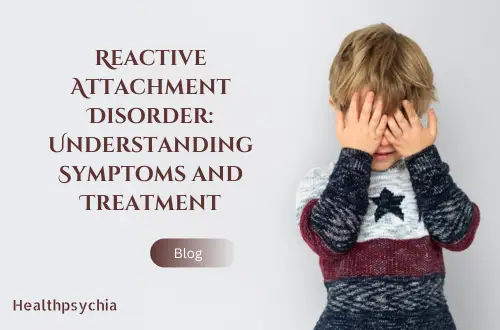Reactive Attachment Disorder (RAD) is a complex condition affecting children who have not formed healthy emotional connections with their primary caregivers before age five due to grossly negligent care.
Attachment is a crucial aspect of a child’s development, enabling them to form trusting relationships, regulate emotions, and develop a positive self-image. When attachment is disrupted or absent during the early years of life, it can have profound and long-lasting effects on a child’s physical, emotional and social well-being.
This comprehensive guide explores RAD’s various aspects, including causes, symptoms, diagnosis and treatment options. We will also discuss the importance of early intervention and prevention strategies.
Whether you are a concerned parent, caregiver or healthcare professional this article will give you a deeper understanding of RAD and equip you with the knowledge to support children affected by this condition.
What Is Reactive Attachment Disorder?
RAD is a condition that affects children who don’t form healthy emotional connections with their caregivers due to emotional neglect or abuse.

Children with RAD experience difficulty regulating their emotions and have trouble building meaningful relationships with others. They may not respond to comforting gestures and feel fear or anxiety around their caregivers even when receiving love and care.
Understanding Attachment
Attachment refers to an intense emotional connection between infants and their primary caregivers.
This bond is formed through consistent and responsive caregiving. The caregiver meets the child’s physical and emotional needs and provides comfort. It also gives soothing and creates a feeling of safety.
When a child feel safe in their attachment relationship they grow trust, empathy and the ability to form healthy relationships throughout their lives.
The Impact of Neglect
When a child feels negligence and inadequate care the healthy attachment is hindered. For example, it can be apparent in many ways
- Lack of physical affection
- Emotional unavailability
- Inconsistent caregiving
A child may struggle to develop confidence and trust when he is not found the care and safety he needs. This disturbance in attachment can profoundly affect the child’s overall growth and well-being.
Reactive Attachment Disorder Symptoms
RAD symptoms can differ based on a child’s age. Younger kids may display subtle signs, while older children may have more obvious emotional and behavioral issues.
It’s worth noting that not all RAD cases are the same, and symptoms may differ from person to person.

Symptoms in Infants and Toddlers
In infants and toddlers, the symptoms of RAD may include:
Limited Emotional Responsiveness: Infants and toddlers with RAD may show limited emotional range, appearing unresponsive to comfort and lacking typical expressions of joy, sadness, or fear.
Avoidance of Physical Contact: Children with RAD may actively avoid physical touch, especially from their caregivers.
Lack of Eye Contact: A child with RAD may have difficulty making eye contact with their caregivers.
Eye contact is essential to building emotional connections and engaging in social interactions.
Tantrums and Irritability: RAD can manifest in increased tantrums, irritability, and oppositional behavior.
Unexplained Sadness or Unhappiness: Infants and toddlers with RAD may exhibit signs of unhappiness or sadness without an apparent cause.
Symptoms in Older Children
As children with RAD grow older, their symptoms may evolve and manifest differently.
Two distinct patterns of symptoms are often observed in older children with RAD:
- Inhibited RAD
- Disinhibited RAD
Inhibited RAD
Children with inhibited RAD may display the following symptoms:
- Detachment
- Inhibit their Emotions
- Withdrawal and Avoidance
Disinhibited RAD
Children with disinhibited RAD may exhibit the following symptoms:
- Indiscriminate Sociability
- Inappropriate Familiarity
- Lack of Preference for Primary Caregivers
- Developmental Regression
Inhibited RAD vs. Disinhibited RAD
It is essential to distinguish between inhibited RAD and disinhibited RAD as they signify dissimilar attachment difficulties.
Inhibited RAD is categorized by emotional withdrawal, inhibited behavior and a preference for solitude. At the same time, disinhibited RAD is marked by indiscriminate sociability, inappropriate familiarity and a lack of appreciation for primary caregivers.
Each pattern requires specific therapeutic approaches and interventions to address their unique challenges.
Reactive Attachment Disorder Causes and Risk Factors
Reactive Attachment Disorder develops when a child experiences a lack of or disruption in healthy attachment due to grossly negligent care during their early years. The causes of RAD can be multifaceted and involve environmental and parental factors.
Grossly Negligent Care
Consistently ignoring a child’s emotional and physical needs, such as comfort, affection, and stimulation, is grossly negligent care.
- This can take different forms, including:
- Emotional Neglect
- Physical Neglect
- Instability / Disruptions
Emotional neglect happens when a caregiver fails to provide emotional warmth, nurturing, and responsiveness to a child. This can lead to a lack of secure attachment and emotional support.

Physical neglect happens when a caregiver fails to meet a child’s basic physical needs, like nutrition, hygiene and healthcare. This can hinder the formation of a healthy attachment bond.
Last, frequent changes in primary caregivers, like in foster care or institutionalization cases, can cause instability and disruptions.
Parental Factors
Several parental factors can contribute to the development of Reactive Attachment Disorder, including:
- Severe mental health conditions (e.g., depression, anxiety, substance abuse) can hinder parents’ abilities.
- Substance abuse including alcohol and drug addiction, reduces parental responsiveness.
- Involvement in criminal activities (e.g., incarceration) can result in parental absence, disrupting secure attachments and hindering emotional development in children.
Environmental Factors
The child’s environment and living conditions can also play a role in the development of RAD. Environmental risk factors include:
- Children placed in homes or institutions may not get the consistent care and emotional support they need. This can make it hard for them to form strong bonds, especially if there are many different caregivers and no one primary attachment figure.
- In situations like foster care or adoption, having multiple caregivers can also make it difficult to form stable and secure attachments, affecting trust and emotional connections.
- Being separated from caregivers for a long time such as during hospitalization can also disrupt attachment development and lead to trust issues.
Understanding Reactive Attachment Disorder’s causes and risk factors is essential for implementing effective prevention strategies and providing appropriate interventions for affected children and families.
How Common Is Reactive Attachment Disorder?
Determining the number of people with Reactive Attachment Disorder (RAD) can be challenging.
However, RAD is rare and tends to occur more often in certain groups of people who are at a higher risk of developing it such as children in foster care or those who have been institutionalized.
Even if a child doesn’t have an official diagnosis of RAD they and their family may still face challenges related to attachment disruptions. Identifying and addressing these issues promptly is essential to promote positive outcomes and reduce the long-term effects of RAD.
Reactive Attachment Disorder Diagnosis
Diagnosing Reactive Attachment Disorder involves comprehensively evaluating a child’s symptoms, behaviors, and developmental history. Mental health professionals, such as child and adolescent psychiatrists or psychologists, are trained to assess and diagnose RAD. The diagnostic process typically involves a combination of the following components:
Medical Evaluation
A thorough medical evaluation is essential to rule out any underlying physical conditions or medical causes that may contribute to the child’s symptoms. The medical assessment may include:
Medical History
- Gathering information about the child’s health history
- developmental milestones
- previous medical or psychiatric diagnoses
Physical Examination
- Conduct a physical examination to assess the child’s overall health
- Identify any physical signs or symptoms that may be relevant to the diagnosis
Laboratory Tests
- In some cases, specific laboratory tests such as blood tests or neuroimaging
- May be conducted to rule out any underlying medical conditions or assess the impact of medications on the child’s symptoms
Psychological Assessment
Psychological assessments are crucial for evaluating a child’s behavioral and emotional functioning. These assessments may involve:
- Clinical Interviews
- Behavioral Observations
- Standardized Assessments
It is significant to note that diagnosing RAD can be complex as the symptoms may overlap with other mental health conditions, such as autism spectrum disorder or attention-deficit/hyperactivity disorder (ADHD).
Therefore, a comprehensive evaluation by qualified professionals is essential to ensure an accurate diagnosis and appropriate treatment planning.
Reactive Attachment Disorder Treatment
The treatment of Reactive Attachment Disorder requires a comprehensive and multidimensional approach that addresses the child’s emotional, developmental and relational needs.
The goals of treatment are to provide a safe and nurturing environment for the child and promote healthy attachment relationships. The treatment plan may include a combination of the following strategies.
Creating a Safe Environment
Ensuring the child’s safety and well-being is the priority in treating RAD. This involves:
- Stable Caregiver Relationships
- Safe and Predictable Environment
- Emotional and Physical Safety
Therapeutic Approaches
Therapeutic interventions are crucial in helping children with RAD develop healthy attachment relationships and address their emotional and behavioral difficulties. Some common therapeutic approaches include:
- Attachment-Based Therapy
- Play Therapy
- Trauma-Focused Therapy
- Family Therapy
Parenting Interventions
Parenting interventions play a vital role in supporting caregivers and equipping them with the necessary skills to meet the needs of children with RAD. Some effective parenting interventions include
- Therapeutic Parenting: Therapeutic parenting involves specific strategies and techniques tailored to the needs of children with RAD.
- Education and Support: Providing caregivers with education about RAD, its impact on child development, and effective parenting strategies can empower them to understand and meet their child’s unique needs. Support groups and counseling can also offer emotional support and guidance to caregivers.
- Attachment-Focused Parent-Child Interaction Therapy (PCIT): PCIT is a structured and evidence-based intervention to improve the parent-child relationship. It involves coaching parents in real-time interactions with their child providing immediate feedback and guidance to enhance attachment and positive communication.
Medication
Medication is not typically used as a primary treatment for RAD itself. However, in some cases, medication may be prescribed to manage specific symptoms or co-occurring conditions, such as depression, anxietyor attention difficulties.
Medication should always be used in conjunction with therapeutic interventions and under the guidance of a qualified healthcare professional.
It is essential to recognize that the treatment of RAD is a complex and long-term process that requires ongoing support, collaboration, and patience from caregivers, healthcare professionals, and the child’s support network.
With early intervention and comprehensive treatment, children with RAD can significantly improve their emotional and relational well-being.
Reactive Attachment Disorder Prevention
While it may not always be possible to prevent Reactive Attachment Disorder entirely, there are steps that caregivers and healthcare professionals can take to promote healthy attachment relationships and reduce the risk of RAD:
Promoting Healthy Attachment
Promoting healthy attachment during a child’s early years is essential to ensure proper emotional development.
- Caregivers can achieve this by being physically and emotionally responsive to the child’s needs.
- This includes providing comfort and nurturing interactions while consistently acknowledging and praising the child’s efforts and achievements.
- Engaging in warm and sensitive communication, such as making eye contact and using soothing vocal tones can help the child develop trust and a sense of security.
Early Intervention
Early intervention is critical to preventing RAD and addressing attachment disruptions. Strategies include
- Developmental Screening
- Parenting Programs
- Supportive Services like Counseling and Support groups.
Conclusion
Children who have not experienced healthy emotional attachments due to neglectful care can develop Reactive Attachment Disorder. This can significantly affect their emotional, behavioral, and social development. Providing support and intervention is essential to recognize and address RAD as early as possible. Caregivers, medical professionals and support networks can help by understanding RAD’s causes, symptoms, and treatment options. With therapy, parenting techniques, and a safe and nurturing environment, children with RAD can form healthy relationships, regulate emotions, and have positive connections.


